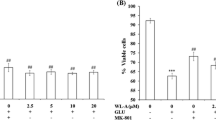Abstract
Epilepsy or the occurrence of spontaneous recurrent epileptiform discharges (SREDs, seizures) is one of the most common neurological disorders. Shift in the balance of brain between excitatory and inhibitory functions due to different types of structural or functional alterations may cause epileptiform discharges.N-Methyl-D-aspartate (NMDA) receptor dysfunctions have been implicated in modulating seizure activities. Seizures and epilepsy are clearly dependent on elevated intracellular calcium concentration ([Ca2+]i) by NMDA receptor activation and can be prevented by NMDA antagonists. This perturbed [Ca2+]i levels is forerunner of neuronal death. However, therapeutic tools of elevated [Ca2+]i level during status epilepticus (SE) and SREDs have not been discovered yet. Our previous study showed fast inhibition of ginseng total saponins and ginsenoside Rg3 on NMDA receptor-mediated [Ca2+]i in cultured hippocampal neurons. We, therefore, examined the direct modulation of ginseng on hippocampal neuronal culture model of epilepsy using fura-2-based digital Ca2+ imaging and neuronal viability assays. We found that ginseng total saponins and ginsenoside Rg3 inhibited Mg2+ free-induced increase of [Ca2+]i and spontaneous [Ca2+]i oscillations in cultured rat hippocampal neurons. These results suggest that ginseng may play a neuroprotective role in perturbed homeostasis of [Ca2+]i and neuronal cell deathvia the inhibition of NMDA receptor-induced SE or SREDs.
Similar content being viewed by others
References
Behr, J., Heinemann, U., and Mody, I., Kindling induces transient NMDA receptor-mediated facilitation of high-frequency input in the rat dentate gyrus.J. Neurophysiol., 85, 2195–2202 (2001).
Bliss, T. V. and Collingridge, G. L., A synaptic model of memory: long-term potentiation in the hippocampus.Nature, 361, 31–39 (1993).
Burgess, D. L. and Noebels, J. L., Single gene defects in mice: the role of voltage-dependent calcium channels in absence models.Epilepsy Res., 36, 111–122 (1999).
Chapman, A. G., Glutamate and epilepsy.J. Nutr., 130, 1043S-1045S (2000).
Choi, D. W., Glutamate neurotoxicity and diseases of the nervous system.Neuron, 1, 623–634 (1988).
Churn, S. B., Anderson, W. W., and DeLorenzo, R. J., Exposure of hippocampal slices to magnesium-free medium produces epileptiform activity and simultaneously decreases calcium and calmodulin-dependent protein kinase II activity.Epilepsy Res., 9, 211–217 (1991).
Clifford, D. B., Olney, J. W., Benz, A. M., Fuller, T. A., and Zorumski, C. F., Ketamine, phencyclidine, and MK-801 protect against kainic acid-induced seizure-related brain damage.Epilepsia, 31, 382–390 (1990).
Clifford, D. B., Olney, J. W., Maniotis, A., Collins, R. C., and Zorumski, C. F., The functional anatomy and pathology of lithium-pilocarpine and high-dose pilocarpine seizures.Neuroscience, 23, 953–968 (1987).
DeLorenzo, R. J., Pal, S., and Sombati, S., Prolonged activation of theN-methyl-D-aspartate receptor-Ca2+ transduction pathway causes spontaneous recurrent epileptiform discharges in hippocampal neurons in culture.Proc. Natl. Acad. Sci. U.S.A., 95, 14482–14487 (1998).
Gulyas-Kovacs, A., Doczi, J., Tamawa, I., Detail, L., Banczerowski-Pelyhe, I., and Vilagi, I., Comparison of spontaneous and evoked epileptiform activity in threein vitro epilepsy models.Brain Res., 945, 174–180 (2002).
Horn, R. and Marty, A., Muscarinic activation of ionic currents measured by a new whole-cell recording method.J. Gen. Physiol., 92, 145–159 (1988).
Honchar, M. P., Olney, J. W., and Sherman, W. R., Systemic cholinergic agents induce seizures and brain damage in lithium-treated rats.Science, 220, 323–325 (1983).
Jahr, C. E. and Stevens, C. F., Calcium permeability of theN-methyl-D-aspartate receptor channel in hippocampal neurons in culture.Proc. Natl. Acad. Sci. U.S.A., 90, 11573–11577 (1993).
Kim, D., Song, I., Keum, S., Lee, T., Jeong, M. J., Kim, S. S., McEnery, M. W., and Shin, H. S., Lack of the burst firing of thalamocortical relay neurons and resistance to absence seizures in mice lacking alpha(1G) T-type Ca(2+) channels.Neuron, 31, 35–45 (2001).
Kim, S., Ahn, K., Oh, T. H., Nah, S. Y., and Rhim, H., Inhibitory effect of ginsenosides on NMDA receptor-mediated signals in rat hippocampal neurons.Biochem. Biophys. Res. Commun., 296, 247–254 (2002).
Mosmann, T., Rapid colorimetric assay for cellular growth and survival: application to proliferation and cytotoxicity assays.J. Immunol. Methods, 65, 55–63 (1983).
Noebels, J. L., The biology of epilepsy genes.Annu. Rev. Neurosci., 26, 599–625 (2003).
Pal, S., Sombati, S., Limbrick, D. D., and DeLorenzo, R. J.,In vitro status epilepticus causes sustained elevation of intracellular calcium levels in hippocampal neurons.Brain Res., 851, 20–31 (1999).
Raol, Y. H., Lynch, D. R., and Brooks-Kayal, A. R., Role of excitatory amino acids in developmental epilepsies.Ment. Retard. Dev. Disabil. Res. Rev., 7, 254–260 (2001).
Rice, A. C. and DeLorenzo, R. J., NMDA receptor activation during status epilepticus is required for the development of epilepsy.Brain Res., 782, 240–247 (1998).
Scheffer, I. E. and Berkovic, S. F., The genetics of human epilepsy.Trends Pharmacol. Sci., 24, 428–433 (2003).
Schwob, J. E., Fuller, T., Price, J. L., and Olney, J. W., Widespread patterns of neuronal damage following systemic or intracerebral injections of kainic acid: a histological study.Neuroscience, 5, 991–1014 (1980).
Sombati, S. and Delorenzo, R. J., Recurrent spontaneous seizure activity in hippocampal neuronal networks in culture.J. Neurophysiol., 73, 1706–1711 (1995).
Stasheff, S. F., Anderson, W. W., Clark, S., and Wilson, W. A., NMDA antagonists differentiate epileptogenesis from seizure expression in anin vitro model.Science, 245, 648–651 (1989).
Sun, D. A., Sombati, S., and DeLorenzo, R. J., Glutamate injury-induced epileptogenesis in hippocampal neurons: anin vitro model of stroke-induced “epilepsy”.Stroke, 32, 2344–2350 (2001).
Westbrook, G. L., Glutamate receptor update.Curr. Opin. Neurobiol., 4, 337–346 (1994).
Wong, C. G., Bottiglieri, T., and Snead, O. C., GABA, gamma-hydroxybutyric acid, and neurological disease.Ann. Neurol., 54 Suppl 6, S3–12 (2003).
Author information
Authors and Affiliations
Corresponding author
Rights and permissions
About this article
Cite this article
Kim, S., Rhim, H. Ginsenosides inhibit NMDA receptor-mediated epileptic discharges in cultured hippocampal neurons. Arch Pharm Res 27, 524–530 (2004). https://doi.org/10.1007/BF02980126
Received:
Issue Date:
DOI: https://doi.org/10.1007/BF02980126




